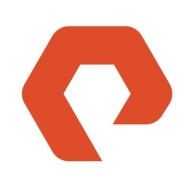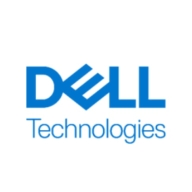


Find out what your peers are saying about MinIO, Red Hat, Nutanix and others in File and Object Storage.
With OpenShift combined with IBM Cloud App integration, I can spin an integration server in a second as compared to traditional methods, which could take days or weeks.
Moving to OpenShift resulted in increased system stability and reduced downtime, which contributed to operational efficiency.
I would rate them an eight out of ten.
There is a lack of SUSE Linux experts which affects the level of support.
The response time and quality of the technical support are satisfactory.
Customer support is generally good but sometimes struggles with complex issues.
Red Hat's technical support is responsive and effective.
I have been pretty happy in the past with getting support from Red Hat.
Red Hat's technical support is good, and I would rate it a nine out of ten.
Through the fabrics, it provides the clustering, allowing us to add nodes easily.
It allows scale-out processes by adding extra nodes, providing flexibility for customers to increase capacity on demand.
I would rate scalability between eight or nine, as it provides a good ability to scale and expand storage.
The on-demand provisioning of pods and auto-scaling, whether horizontal or vertical, is the best part.
OpenShift's horizontal pod scaling is more effective and efficient than that used in Kubernetes, making it a superior choice for scalability.
Red Hat OpenShift scales excellently, with a rating of ten out of ten.
In case there is any issue with any blade, the data is moved to another.
We have not experienced any outages in the last four years.
I'd rate stability maybe 9.5 out of ten.
Dell ECS provides high stability compared to other object solutions.
It provides better performance yet requires more resources compared to vanilla Kubernetes.
I've had my cluster running for over four years.
It performs well under load, providing the desired output.
Its configuration should be easier.
Live logs should be viewable through the GUI like with Logstash or Elasticsearch.
The deployment is not easy, and some expertise is required to configure the virtual data center and replication groups.
Incorporating extra integrations beyond S3, like Hadoop file systems, and being well aligned with trends like AI solutions would be beneficial.
Learning OpenShift requires complex infrastructure, needing vCenter integration, more advanced answers, active directory, and more expensive hardware.
We should aim to include VMware-like capabilities to be competitive, especially considering cost factors.
The removal of Grafana and HPA from monitoring caused some issues.
It relies on nearline SAS drives, which are cheaper than flash or SSDs.
The pricing model is on the higher side compared to other vendors.
The price is reasonable given the abundance of features, including managing, control, host resources, dockers, and containers.
Initially, licensing was per CPU, with a memory cap, but the price has doubled, making it difficult to justify for clients with smaller compute needs.
Red Hat can improve on the pricing part by making it more flexible and possibly on the lower side.
The cost of OpenShift is very high, particularly with the OpenShift Plus package, which includes many products and services.
We can plug in many blades, and we can have data up to one terabyte.
The stability of this solution is a major advantage, as we've not experienced any outages in the last four years.
If we encounter any issues or need to upgrade anything, we can simply open a ticket, and the EMC team is there to assist us.
Dell ECS is very easy to handle, primarily because the web UI dashboard and everything is very easy to manage for every customer.
The concept of containers and scaling on demand is a feature I appreciate the most about Red Hat OpenShift.
A valuable feature of Red Hat OpenShift is its ability to handle increased loads by automatically adding nodes.
It has features that enhance security, ease of deployment, and service exposure compared to Kubernetes.



FlashBlade is the industry’s most advanced scale-out storage for unstructured data, powered by a modern, massively parallel architecture to consolidate complex data silos (like backup appliances and data lakes) and accelerate tomorrow’s discoveries and insights.
Enterprise-ready. Future-proof. Data-first.
Dell EMC Elastic Cloud Storage (ECS) is a file and object storage solution from Dell EMC. ECS has been created to support both traditional and next-generation ecosystems equally. ECS boasts unrivaled economics, manageability, resilience, and scalability to satisfy the demands of today's next-gen, robust business enterprise ecosystems. ECS can easily be deployed in a software-defined model or as a turn-key appliance. ECS is software-defined and multi-layered for unlimited scalability. Every layer is abstracted and scalable with no single point of failure.
Everything is done within the software, which is containerized, using docker.
ECS is currently deployed using basic commodity hardware, which can easily be federated across as many as eight different locations and managed as a single resource. Additionally, ECS can also protect data at the site level, locally, disk, node, and rack levels. The federation enables a single global namespace with everywhere access to content. Applications can quickly rewrite in an active/active or everywhere active manner.
ECS is also able to be used as secondary storage or archival storage. This will free up valuable primary storage of data that is stale, redundant, or used infrequently, and the data will remain easily accessible. ECS uses policy-based tiering such as Data Domain, Cloud tiering, Isilon using cloud polls, and Geodrive, which give Windows systems direct access to ECS. Windows users can still use server message block (SMB) while leveraging the more expansive ECS storage.
ECS is enterprise-grade and offers valuable features such as retention, multi-tenancy, metering, monitoring, quotas, and more. ECS builds in robust security from the ground up and encrypts data. ECS is compliant with STIG guidelines and adheres to SEC rule 17A-4F.
ECS is an enterprise-ready solution that allows organizations to easily simplify object storage management and visualize information in intuitive new ways, and empowers your business to do even more with data. With ECS, enterprise organizations can deliver cloud-scale economics in-house that will lower total cost of ownership (TCO) and scale, creating greater levels of productivity and profitability.
Reviews from Real Users
One user, who is a deputy director at a tech service company, says ECS offers “good performance, reliability, and technical support”.
Dell EMC ECS is “a stable solution which is easy to scale, install and manage”, relates another user, who is a senior buyer at a tech service company.
"What I like best about this product is that it is a complete solution, both hardware, and software, by the same vendor," summarizes a system engineer at a tech services company.
Red Hat OpenShift offers a robust, scalable platform with strong security and automation, suitable for container orchestration, application deployment, and microservices architecture.
Designed to modernize applications by transitioning from legacy systems to cloud-native environments, Red Hat OpenShift provides powerful CI/CD integration and Kubernetes compatibility. Its security features, multi-cloud support, and source-to-image functionality enhance deployment flexibility. While the GUI offers user-friendly navigation, users benefit from its cloud-agnostic nature and efficient lifecycle management. However, improvements are needed in documentation, configuration complexity, and integration with third-party platforms. Pricing and high resource demands can also be challenging for wider adoption.
What are the key features of Red Hat OpenShift?Red Hat OpenShift is strategically implemented for diverse industries focusing on container orchestration and application modernization. Organizations leverage it for migrating applications to cloud-native environments and managing CI/CD pipelines. Its functionality facilitates efficient resource management and microservices architecture adoption, supporting enterprise-level DevOps practices. Users employ it across cloud and on-premises platforms to drive performance improvements.
We monitor all File and Object Storage reviews to prevent fraudulent reviews and keep review quality high. We do not post reviews by company employees or direct competitors. We validate each review for authenticity via cross-reference with LinkedIn, and personal follow-up with the reviewer when necessary.